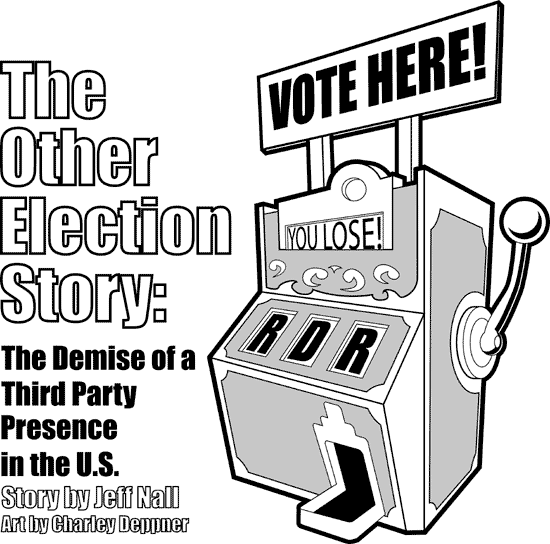Donate to IMPACT
Click below for info


• 3rd Party Demise
• Quickies
(music reviews)
 • E-Mail Comments
• Archives
• Subscribe to IMPACT
• Where to Find
IMPACT
• Buy IMPACT T-Shirts
• Ordering Back Issues
• Home
|

The election results are in.
For better or worse, George Bush has been reelected. And while progressives as well as moderates in both the Democratic and Republican parties ponder the daunting possibilities of four more years of W (i.e. the wars on peace, women, separation of church and state, fiscal responsibility and civil liberties), the president having been reelected is only half of the story.
Despite Ralph Nader's warning to Democrats on November 3rd to "stay tuned: We are just beginning to fight" ("Nader Ends Presidential Campaign," Associated Press, November 3, 2004) the 2004 election has solidified a 12 year decline in third party voting. Whereas more than 20 million votes were cast for third party candidates in 1992, 10 million in 1996, and nearly 4 million in 2000, just over 1 million votes (less than 1 percent) were cast for candidates outside of the two major parties in 2004. Not since 1984, the last time third party candidates received less than 1 percent of the vote, has the hegemony of the two major parties been so apparent.
While some may attribute this year's decline to the Democrats' successful legal campaign to keep Nader's name off of the ballot in many states, much of the opposition to third party candidacies came from within their own ranks. Speaking on behalf of liberals everywhere, fearful of the prospect of Bush's reelection, The Nation's editorial board implored Nader not to run; even an editorial in IMPACT featured a plea for voters not to vote for Nader. But such invectives were as much an assault on the plurality voting method employed to elect the president as they were attacks on candidates such as Nader.
The plurality voting method, which is the most commonly applied method in the U.S., requires voters to choose only one candidate, ruling out the option of selecting a secondary choice. And because the plurality method does not allow third party voters to specify a second or third choice, a vote for Nader, for instance, may effectively result in a vote for Bush. In fact, many analysts believe that the 2000 election would not have come down to a few thousand potentially miscounted ballots in Florida, had the preference of third party voters been taken into consideration in determining whether Bush or Gore should become president. In a November 6 New York Times article, Sandy Maisel of the Goldfarb Center for Public Policy at Colby College was quoted as saying, "Those who chose Nader over Al Gore in 2000 realized what they'd done and bolted for Kerry" ("Nader Is Left With Fewer Votes, and Friends, After '04 Race," New York Times online, November 6, 2004).
According to Anthony Lorenzo, chair of the Political Action Committee Coalition for Instant Runoff Voting (CIRV) in Florida, without revamping the voting methodology minor parties can only go so far.
"Minor parties–the Progressive Party, specifically, as it was the most successful historically, I think–have a destiny, according to historical data, to get so far in our system," says Lorenzo. "Once they begin to win, they are merged with one of the majors by the major party adopting some or all of their platform–Social Security, etc. Other than that, they are destined to fade away in a plurality system and be a nuisance to the majors."

Though Democrats may see Nader's diminished support as a victory of sorts, third party organizations are not the only ones that stand to benefit from a change in the limiting voting system. In the recent election, third party candidates managed to greatly influence the results of three important state races, highlighting the failures of non-preferential voting methods. In the hotly contested battle for Florida's open Senate seat, Republican Mel Martinez beat out Democrat Betty Castor by a margin of less than 82,000 votes. In that same race, Veterans Party of America candidate, Dennis Bradley, earned just over 162,000 votes. While it's difficult to determine whether most of Bradley supporters would have favored Castor, it is not unrealistic to think that Martinez's one percent margin of victory would have been affected had Bradley supporters been given a choice between the top two candidates.
On the other side of the country, Washington state election officials were, as of November 26, still trying to determine the winner of the state's gubernatorial race. After a recount, Republican Dino Rossi led Democrat Christine Gregoire by just 42 votes, while Libertarian candidate Ruth Bennett successfully garnered over 63,000 votes. A second recount is expected.
And in Alaska, yet another Senate race was won by a candidate who failed to win by a majority vote. Republican Lisa Murkowski received just 49 percent of the vote, beating out Democratic challenger Tony Knowles by fewer than 11,000 votes. In contrast, nearly 14,000 Alaskans voted for one of five third party candidates.
Despite the appearance that a shift in voting methods would only stand to benefit Democrats, apparent losers in each of the aforementioned races, the fact is not all third party voters are liberal. And, interestingly, the only state in which third party presidential candidates prevented one of the two major candidates from obtaining the majority of the vote was in Wisconsin, a blue state won by John Kerry. Kerry won the state by fewer than 12,000 votes, while more than 26,000 votes were cast for one of five third party candidates.
Clearly those who voted for third-party candidates in Florida, Alaska, Washington, and Wisconsin could have played a key role in producing a more decisive outcome had their secondary preferences been taken into consideration. Ironically, the fundamental issue of the way we count (attribute value to) each vote has been consistently overshadowed by the debate over hanging chads, electronic malfunctions, and concern over paperless machine manipulation.
Responding to what they see as the prejudice and the ineptitude of the plurality method, in providing voters with the freedom of choice or in procuring decisive victors, many Americans have begun advocating a number of alternatives, including Instant Runoff Voting (IRV). According to the Center for Voting and Democracy (CVD), a Maryland-based non-profit organization dedicated to fair elections, "Instant runoff voting is a winner-take-all, constitutionally-protected voting system that ensures a winning candidate will receive an absolute majority of votes rather than a simple plurality. IRV eliminates the need for runoff elections by allowing voters to rank their candidates in order of preference." In such a system, each voter ranks as many candidates as they would like to take office starting with their first preference. The majority vote must be attained. If, after the first round of tallying votes, no candidate has earned the majority then the candidate with the least favor among voters is eliminated and the process/count begins again. But rather than disregarding those votes cast in favor of the eliminated candidate, the second choice then becomes the candidate most favored (and so on). Currently Australia, Ireland, and San Francisco use IRV.

Rob Richie, executive director for the CVD, believes IRV will achieve fair representation in the White House. "We've put our money on IRV for a couple of reasons. One, there's a simple logic to it, which is people have preferences as long as their first choice has a chance to win. Typically, they want that person to win," says Richie. At the same time, he says, if a person's first choice fails to climb into the top two candidates, his or her second choice should be counted.
Robert Loring, owner and director of AccurateDemocracy.com, also believes IRV is an effective voting method. "The election of a president, governor, or mayor who can veto legislation needs to be linked to the rules and time of election for the legislature," he said. "Otherwise the two powers are more likely to reach a deadlock over differences in policy and funding. IRV then is the best rule for electing a chief executive."
According to Lorenzo, whose group CIRV is working to bring IRV to communities throughout Florida, minority parties aren't the only ones with something to gain from IRV but so do the two dominant parties.
"There are many examples of how IRV would help this or that group," Lorenzo says. "For instance, in 2000, Al Gore would have won Florida according to results, assuming Greens would have voted for Gore second. In 1992, Ross Perot took enough votes from the Republicans to elect Clinton and defeat Bush. The pendulum swings both ways. The point of IRV is to ensure that the winner is supported by the majority of Americans. IRV on its own doesn't change anything other than the way the votes are tabulated."
According to CVD's web site, notable supporters of IRV include Democrat Howard Dean, and even Republican Senator John McCain.
Lorenzo says IRV benefits everyone involved, especially voters. "Everyone benefits because we get a government that is truly representative of the majority who vote. By requiring a majority with IRV, we ensure that most people are happy with the winners of elections. Also, in areas where second runoff elections are conducted, these second elections are expensive and elimination of second elections saves taxpayers money," Lorenzo explains. "In my city, Sarasota [Florida], that amounts to $37,000 per election. They are conducted every 2 years and there has been a runoff each year since they reinstated runoffs. San Francisco has demonstrated that IRV also has another interesting side effect: cooperation amongst competitors for the same office and an election almost devoid of negative campaigning. When candidates are inspired to talk issues, we all benefit from the ability to make a more informed decision as voters. I think everyone is sick of the draft dodger, traitor, etc. attacks characteristic of the more visible races. They turn everyone off and it is a convenient way to avoid discussing issues."
But after years of witnessing their vote inadvertently support the candidate most antipathetic to their real choice, third party voters are now caving to the realistic demands of the current voting system: vote Democrat or Republican, or don't bother voting.
"Without IRV," explains Lorenzo, "people fear voting their conscience. I mean, look at Dennis Kucinich's race for the Democratic nomination and how he faired. He got very few votes as most Democrats were trying to pick the candidate who Ścould beat Bush.' In fact, everyone I spoke to supported Kucinich, yet they feared he could not win. In IRV, we can support the best candidate. We can vote our conscience."
A change in voting methodology would likely increase voter turnout, reduce costs in some places, and, at the least, contribute to the expansion of an often stifled, calcified exchange of ideas. Despite the decline in presidential election minority-party voting, history has shown that millions of Americans do prefer a plethora of candidates to choose from. But to stay the current course, the U.S. runs the risk of not only losing important dissenting voices from minority party politicians, but also risks the alienation of millions of Americans who want more than to cynically cast votes for the less despised candidate.
Though the nation is understandably concerned with the victor and loser of the 2004 election, the ever-increasing tendency of voters to sacrifice their true vision of America in exchange for a murky reflection of that ideal is equally as significant and deserves the attention of the country.
•
Jeff Nall is a Central Florida-based writer. He has written for various publications including IMPACT press, Z magazine, Clamor, Liberty, Freethought Today, Toward Freedom and Utne (web-watch).
Email your feedback on this article to editor@impactpress.com.
Make an IMPACT
Other articles by Jeff Nall:
|





